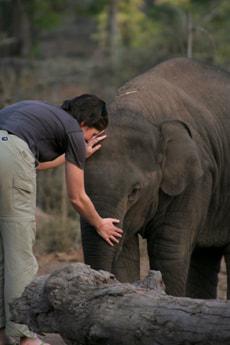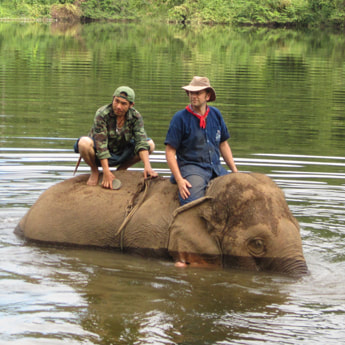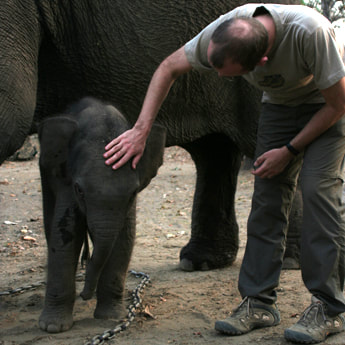Okay, so clearly 3 months post-term is not going to be a human baby. This baby weighed somewhere between 90-120 kg and took over 22 months to “cook” in his 35-year-old mum Thi-Hi-Way. Yep, he’s an elephant calf, and his keepers at Chester Zoo were caught completely by surprise when they came in to work on Friday morning to find a new-born elephant calf amongst their herd of Asian elephants. Wow what a job! They had thought his mum had miscarried as she had gone long past her due date, but low-and-behold they were wrong… I hope they call him Harry for obvious reasons!
http://www.chesterstandard.co.uk/news/16239014.Surprise_baby_elephant_birth_at_Chester_Zoo_astonishes_keepers/
What is EEHV?
Elephant endotheliotropic herpesvirus (EEHV), or Elephantid hepervirus 1, is a double-stranded DNA herpes virus that can cause infections in young Asian elephants. There are currently nineteen known types and subtypes of the virus. EEHVs share between 25-40% genetics with human herpes viruses but there is no cross species infection; the viruses are species specific.
It is from the genus Probosciviruses; no prize for guessing that this name has something to do with the elephant’s trunk as proboscis usually means an elongated or mobile nose!
EEHVs have been known about since the 1970s when they were first identified in African elephants where they are usually benign but occasionally cause small skin growths. It has been found that the benign EEHVs normally found in African elephants are different to those causing severe infections in Asian elephants. It wasn’t until 1995 when the first fatal case of EEHV infection occurred in an Asian elephant in captivity at the National Zoo in Washington D.C., USA. Following this case, researchers looked back at stored tissue samples from Asian elephants that had died in captivity and found other cases going back to 1983.
It is likely that this virus has been around for longer and it may be that stored samples don’t go back further than this; 56 more cases have so far been identified. The latest deaths were two calves at Whipsnade Zoo in the UK in 2009.
So having found the virus in captive elephants does it occur in the wild or is this yet another man-made problem? In the last five years over 30 infections have been detected in wild Asian elephants across Thailand, Cambodia, Myanmar and Indonesia. So this is a natural infection of elephants whether they are in captivity or in the wild. I’ll take my cynical hat off!
How does EEHV present?
Many adult elephants have asymptomatic infection with EEHV which has been shown by testing blood, saliva and even trunk washings (which I suspect is the equivalent of a nasopharyngeal aspirate in humans… except with a lot more saline!). Latent infection also occurs with intermittent shedding of virus in saliva and trunk secretions; the same occurs with herpes viruses in humans where latent infection and reactivation occurs; Herpes Simplex Virus (HSV) causing cold sores and Varicella Zoster Virus (VZV) causing shingles.
More worryingly EEHV can cause a fatal haemorrhagic disease, usually in young Asian elephants. The elephant presents with oedema of the head and trunk (fluid in tissues), central cyanosis (indicating poor oxygenation of blood), lethargy and poor appetite. Widespread petechiae (bleeding into the skin causing a purple rash) occur with eventual haemorrhage affecting most of the major body organs. Death usually occurs within 1-5 days.
From known cases 50% of infections occur within the first 4 years of life with a further 25% occurring from 4 to 8 years old. Of the known cases, 90% have occurred in Asian elephants.
Unfortunately this is not a rare infection in captive Asian elephants. There had been 78 Asian elephants born in captivity up until 2007, 19 (24%) developed symptomatic EEHV infection and 14 of these 19 died (74%). The mortality is very high; in comparison Ebola in humans in West Africa had a mortality of 50%.
How is EEHV diagnosed?
EEHV is diagnosed using a PCR test on tissue or blood from elephants showing signs of infection. This is a specific test for the elephant’s herpes viruses. NB. Please do not send these samples to your normal human microbiology laboratory!!
However there appear to be a number of laboratories around the world that do offer this PCR test and strangely the lab in the UK is just a few miles down the road from Nuts & Bolts HQ in Addlestone, Surrey (I wonder if they need the help of a Microbiologist?!).
Can EEHV be treated?
The current treatment of EEHV is Famciclovir. Famciclovir is also available to treat herpes infections in humans; it is a pro-drug of Penciclovir and very similar to Aciclovir. In humans it is licensed in the UK for the treatment of both HSV and VZV infection. In elephants, as with human infections, this drug should be started as soon as infection is suspected. So far it has been “successfully” used to treat 8 elephants with EEHV but this is only 1 in 3 cases; I suspect it just isn’t started soon enough in most patients.
A daily elephant dose of Famciclovir costs £1500 (one elephant is likely to need anti-viral medicine for at least 1-2 weeks!) the normal dose in humans costs about £50 per day… so cost is also probably a key factor in delayed treatment of elephants in resource poor countries, or even in zoos! Chester zoo has a donate page to help raise money for treatment and research. As a Clinical Microbiologist and a fan of elephants, I'm happy to support Chester Zoo's work into EEHV.
Infection control?
So far all cases of EEHV occurring in captivity have only been locally linked; there has been no EEHV found in more than one place at the same time to suggest an outbreak or cross infection between institutions, or that there is a single strain of virus in the wild that is particularly good at causing infection which might have been imported to those institutions.
Outbreaks of specific EEHV strains have occurred within herds, either suggesting cross infection or sustained carriage and reactivation in other members of the herd over time. It is suspected that latent infection is the main cause of these outbreaks as there can be considerable time, even years, where there are no cases and then a case occurs with an identical strain to the one seen years earlier. Herpes viruses cannot survive that long in the environment therefore it has to be reactivation of latent virus.
Having said that cross infection has been reported, and given how these viruses transmit easily in humans this isn’t surprising, so it would seem wise to isolate infected calves from non-infective calves as much as possible. How this would actually be done in such a close knit herd is beyond me… and I suspect if a matriarch of a herd really decided she wanted the mother and calf back then she might just go and get them… whatever and whoever was in the way… maybe zoo keeper is not the job for me… thankfully human patients are considerably smaller.
So if you want to know more I have found an excellent resource in the EEHV Advisory Group online at http://eehvinfo.org//
And for the new-born calf check out Chester Zoo… they are rightfully proud of their “little” boy and his mum! They are involved in International efforts to prevent the extinction of these wonderful animals and have a charity called “We Will Never Forget” which supports research into EEHV… and no, I don’t have an affiliation to them… I just love elephants… have I mentioned that already?
Elephants in Asia are used like horses in other parts of the world, they work and they are ridden, however trying to bridal an elephant isn’t practical. Chains are like a horse’s bridal, they are clean, safe and robust. They also give a “boundary” for the elephant, it knows it stays put… but really… if it wanted to, it would pull or push the tree down and “leave” if it so choose. Even humans live by these “boundaries” we could for example steal, if we wanted to, but we generally don’t choose to, we accept the boundary. If elephants were not tethered they would walk anywhere they wanted, they would destroy other people's trees and farmland, not knowing this is not OK for those people. Likewise horses are in fenced fields and often stabled at night, dogs are on leads and in kennels. If domestic elephants in Asia become a pest they can get killed or resented. Human elephant conflict is the biggest threat facing elephants in the wild in Thailand. Chains at night keep domestic elephants safe. During the day the elephants coil the chain up and carry it… “but that’s heavy” I hear you cry… really… when you see them tear up a full grown tree and carry that … a chain is insignificant… less than carrying a mobile phone to us! Mothers are also chained while in fenced areas because they can easily push over the fence; the chains prevent them crashing around and disturbing their calf, which in turn causes distress to all the mothers and babies in the nursery. Obviously wild animals, horses, wolves or elephants are not chained and this is great…let them be free and human’s should protect and respect this, but working and domestic animals are not wild.



 RSS Feed
RSS Feed
